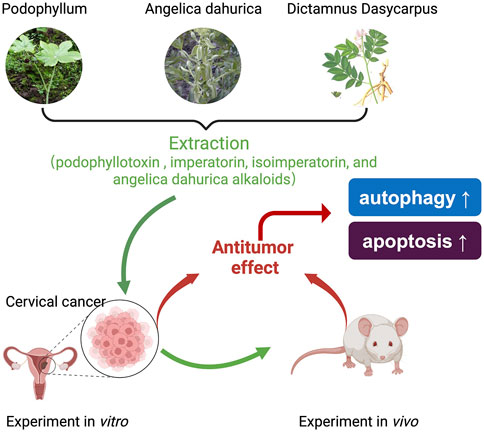Traditional Chinese Medicine Breakthrough: GuiErBai Shows Promise Against Cervical Cancer
Nikhil Prasad Fact checked by:Thailand Medical News Team Jun 11, 2024 10 months, 2 weeks, 1 day, 3 hours, 23 minutes ago
TCM News: Cervical cancer (CC) remains a significant health issue worldwide, ranking as the fourth most prevalent malignant tumor and the fourth leading cause of cancer-related deaths among women globally. According to recent statistics, CC affects approximately 13 out of every 100,000 individuals, resulting in over 341,831 deaths in 2020 alone. The disease predominantly impacts women between the ages of 45 and 49, with many presenting with locally advanced stages at the time of diagnosis.
 Schematic diagram of proposed mechanism. GuiErBai (GEB), a complex formulation, originates from the traditional Chinese medicine of the Miao ethnicity and is composed of podophyllotoxin (PTOX), imperatorin, isoimperatorin, and A. dahurica alkaloids. GEB has demonstrated a potent antitumor efficacy against cervical cancer, both in laboratory experiments and in living organisms, in a manner dependent on the concentration, through the modulation of autophagy and apoptosis in cancer cells.
Schematic diagram of proposed mechanism. GuiErBai (GEB), a complex formulation, originates from the traditional Chinese medicine of the Miao ethnicity and is composed of podophyllotoxin (PTOX), imperatorin, isoimperatorin, and A. dahurica alkaloids. GEB has demonstrated a potent antitumor efficacy against cervical cancer, both in laboratory experiments and in living organisms, in a manner dependent on the concentration, through the modulation of autophagy and apoptosis in cancer cells.
Despite advancements in treatment, including surgery, radiotherapy, and chemotherapy, CC-related mortality rates remain high. The limitations of current treatments, such as drug resistance and severe side effects, highlight the urgent need for new and effective therapies.
GuiErBai: A Traditional Chinese Medicine with Modern Applications
GuiErBai (GEB), a compound preparation developed by researchers at the Central Hospital of Enshi Tujia and Miao Autonomous Prefecture in China, is rooted in the ancient medicinal practices of the Miao ethnic communities. GEB is composed of podophyllotoxin (PTOX), imperatorin, isoimperatorin, and Angelica dahurica alkaloids, each with notable anti-tumor properties.
The study covered in this
TCM News report aimed to validate the anti-tumor efficacy of GEB specifically against cervical cancer. Researchers conducted a series of in vitro and in vivo experiments using HeLa and SiHa cell lines, as well as a nude mouse model, to determine the compound's effectiveness.
Methodology: Rigorous Testing for Reliable Results
The in vitro experiments involved treating HeLa and SiHa cell lines with 5 mg/mL and 10 mg/mL concentrations of GEB. The cell cycle changes were assessed using flow cytometry, while transmission electron microscopy and MDC staining were employed to observe autophagic and apoptotic bodies. Additional tests included the CCK-8 assay for cell proliferation, Transwell assays for cell migration and invasion, and western blotting for protein expression analysis.
For the in vivo experiments, a nude mouse model of cervical cancer was established. The mice were divided into four groups: negative control, positive control, high-dose GEB (10 mg/mL), and low-dose GEB (5 mg/mL). Over the course of the study, tumor growth and protein expression levels were closely monitored.
Results: Promising Anti-Tumor Activity<
br />
The results from both in vitro and in vivo experiments were highly encouraging. In HeLa and SiHa cell lines, GEB treatment significantly decreased the G0/G1 phase and increased the G2/M phase, indicating cell cycle arrest. Electron microscopy revealed that GEB promoted the formation of apoptotic bodies and autophagosomes. Additionally, GEB-treated cells showed reduced caspase3 protein expression and increased levels of the autophagy-related protein LC3I/II.
The Transwell assays demonstrated that GEB significantly inhibited the migration and invasion capabilities of cervical cancer cells. Furthermore, GEB treatment elevated ROS content and mitochondrial membrane potential, suggesting increased oxidative stress and mitochondrial dysfunction in cancer cells.
In the nude mouse model, GEB treatment resulted in a notable reduction in tumor volume and weight, alongside decreased expression of CD34, VEGF, and caspase3 proteins in tumor tissues. These findings collectively highlight the robust anti-tumor activity of GEB against cervical cancer.
Discussion: Potential Implications and Future Directions
The study provides compelling evidence that GEB exhibits significant anti-tumor effects against cervical cancer by regulating autophagy and apoptosis. The concentration-dependent nature of GEB's efficacy underscores its potential as a potent therapeutic agent.
The active phytochemical ingredients in GEB, including PTOX, imperatorin, isoimperatorin, and A. dahurica alkaloids, have been individually recognized for their anti-tumor properties. For instance, PTOX is known for its microtubule and DNA-damaging capabilities, while imperatorin and isoimperatorin have shown efficacy in inducing cell cycle arrest and inhibiting metastasis in various cancer types.
Given the broad anti-tumor effects observed in this study, GEB holds promise not only for treating cervical cancer but potentially other malignancies as well. However, further research is necessary to explore its full therapeutic potential and to optimize its formulation for clinical use.
Conclusion: A Step Forward in Cancer Treatment
The findings from this study mark a significant advancement in the search for effective cervical cancer treatments. GuiErBai, with its roots in traditional Chinese medicine, has demonstrated substantial anti-tumor activity in both laboratory and living organism settings. By modulating autophagy and apoptosis, GEB effectively inhibits the proliferation, migration, invasion, and growth of cervical cancer cells.
As research continues, GEB could become a valuable addition to the arsenal of treatments against cervical cancer, offering new hope to patients worldwide. The journey from traditional remedies to modern therapeutics exemplifies the potential of integrating ancient wisdom with contemporary scientific rigor.
The study findings were published in the peer reviewed journal: Frontiers in Pharmacology.
https://www.frontiersin.org/journals/pharmacology/articles/10.3389/fphar.2024.1296588/full
For the latest
TCM News, keep on logging to Thailand Medical News.
Read Also:
https://www.thailandmedical.news/news/covid-19-herbs-harvard-led-study-shows-effectiveness-of-various-herbs-used-in-traditional-chinese-herbal-formulations-for-treating-covid-19
https://www.thailandmedical.news/news/must-read-china-s-secret-to-controlling-the-covid-19-outbreak-is-traditional-chinese-medicine-concoctions-used-alone-or-in-conjunction-with-antiviral-
